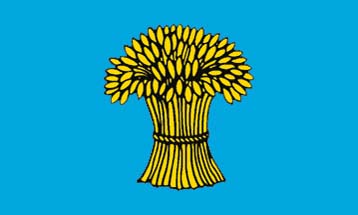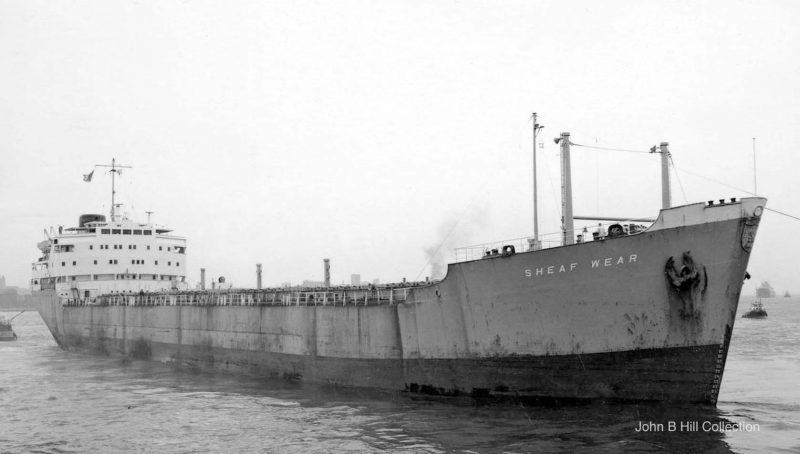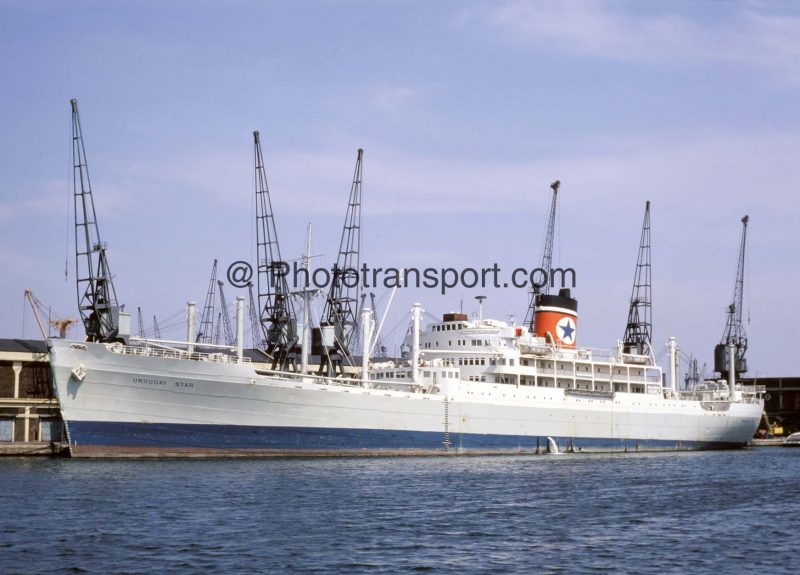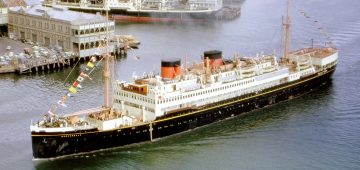The Sheaf Wear – Part Two

 The storm raged unabated as we slowly continued on our way towards Canada, and even when it finally blew itself out the seas and swell still remained huge and the Sheaf Wear pitched and rolled around relentlessly. My life consisted of watch keeping, retching and sleeping, watch keeping, retching and sleeping…. with some more, watch keeping, retching and sleeping, and I’d hardly been sighted outside my cabin or the engine-room since joining the ship. Thankfully, an experienced and compassionate steward recognising my plight had kept me alive on a diet of dried biscuits and fruit which he brought to my cabin, but this was frowned upon and I was eventually summoned to a meeting with the Captain and Chief Engineer, and I felt a twinge of anxiety as I slowly made my way towards the Master’s suite and knocked cautiously on a curtained door frame.
The storm raged unabated as we slowly continued on our way towards Canada, and even when it finally blew itself out the seas and swell still remained huge and the Sheaf Wear pitched and rolled around relentlessly. My life consisted of watch keeping, retching and sleeping, watch keeping, retching and sleeping…. with some more, watch keeping, retching and sleeping, and I’d hardly been sighted outside my cabin or the engine-room since joining the ship. Thankfully, an experienced and compassionate steward recognising my plight had kept me alive on a diet of dried biscuits and fruit which he brought to my cabin, but this was frowned upon and I was eventually summoned to a meeting with the Captain and Chief Engineer, and I felt a twinge of anxiety as I slowly made my way towards the Master’s suite and knocked cautiously on a curtained door frame.
“Enter!” a voice declared.
But before the curtain had time to settle behind me, or my head sweep around and take in the Captain’s spacious day-room, two pairs of eyes were riveted on my feet.
“You didn’t tramp through the accommodation wearing those things?” a gruff voice rasped.
“Take your bloody boots off!” another one growled.
I had no chance to reply, and in a panic tangled the laces and struggled to get them off before standing in my stocking soles as the voice growled again.
“And don’t leave them in here, for gawd’s sake, put them in the alley!”
The Captain and Chief were both in uniform, their jacket sleeves adorned with four bands of thick, gold braid, the Chief’s entwined with purple, and they sat in comfortable armchairs nursing crystal glasses containing an amber fluid, and the Chief inquired, “hasn’t anyone told you to leave your boots in the engine-room?”
I shook my head.
“That’ll cost the Second Engineer a case of beer!” the Captain mused.
“Maybe two?” the Chief pondered.
I was then given a stern lecture about the lethal mixture of a hangover combined with seasickness, but was spared the indignity of being entered into the Captain’s Logbook because I was a first tripper and had attended to my duties as best I could. My interview was obviously over, and as I shuffled away I’m convinced I detected a twitching on his and the Chief Engineer’s lips as they tried not to laugh.
“And don’t forget your boots,” I heard behind me. “Don’t wear them though, just pick the buggers up!”
Gossip travels quickly in a confined community, and Steve pounced on me when I returned.
“What was that all about?”
“Just some fatherly advice.” I sighed, and told him the story.
We ploughed onwards as the wind dropped and sea eased to a moderate swell, but one morning when icebergs were reported in the area we again reduced speed as a precaution and cautiously crept forward at ‘Slow-ahead’, although we never encountered anything bigger that a few cubes that would have fitted comfortably into the Captain and Chief’s tumblers…. and as we neared the coast some friendly slivers of sunlight chinked through the breaking clouds, and a welcoming school of whales frolicked in the distance, their blow-holes sending up columns of water high into the air.
The sky was blue as we brushed through an icy veneer and steamed up the Cabot Straight into the Gulf of St. Lawrence, and with Newfoundland on our starboard and Nova Scotia to our port, the air was crisp and sweet with the unmistakable aroma of land and conifers.
Sept Iles had a large and natural deep-water harbour with its entrance plunging to more than 250 feet, and being a great lover of history I was intrigued to learn that it had been named way back in 1535 by the intrepid seafarer, Jacques Cartier, but there were others who believed that the sheltered bay had been used even earlier by Basque fishermen, hence the local names, Point aux Basque, Ile Grande Basque and Ile Petite Basque.

The Sheaf Wear was edged alongside with the assistance of two tugs, and as soon as we secured, loading commenced from a series of chutes pouring rich iron-ore into her greedy, gaping holds. Our cargo had arrived from the Schefferville Mine some 360 miles into the rugged interior, on a railway line constructed by the ‘Iron Ore Company of Canada’ for the sole purpose of transporting the raw material to the stockpiles and drying kilns in Sept Iles.
The terminal was worked twenty-four hours, seven days a week, but only between July and December depending on the severity of the Canadian winter when an impenetrable ice made the port inaccessible, and now into November there seemed to be a sense of urgency to keep the shipping moving. Sea watches were maintained as our time alongside was expected to be less than a day, but no one seemed terribly desirous of going ashore, except for me, and Steve fidgeted about making feeble excuses. “I really must mend some socks and catch up with all my washing!”
The news spread quickly that I was going into Sept Iles, and I soon had a long list of items to buy and letters to post with even the Captain becoming involved.
“Buy all the things they want,” he instructed me, and carefully counted out one hundred Canadian dollars.
“Get the receipts, and we’ll work it out when you get back…. and you can get a spool for my camera whilst you’re at it!”
And as I strolled into the brilliant Canadian sunshine wondering about this unusual turn of events and unexpected friendliness, I understood why Steve hadn’t answered my question about Canada many days previously, or why no one wanted to accompany me as it wasn’t just cold…. it was freezing. Sept Iles enjoyed an average summer maximum temperature of 20ºC before plummeting to an average winter maximum of -9ºC with snow expected anytime between October and May, and I turned around to go back, but by the time I’d retraced my steps the ship’s gangway had been raised just out of my reach.
“Lower the bloody gangway!” I yelled upwards.
“Can’t!” a beanie and scarf wrapped head muffled. “We’re trimming the ship, so come back when you’ve bought all our stuff!”
The township was only a short distance from the wharf and with little choice I set off again, but at a brisk pace to try and bring back some warmth to my shivering body, and I had visions of finding a lonely outpost store, probably run by a Scotsman and his good wife Morag, and at night they’d hear the baying of wolves and maybe a marauding bear would venture out of the dense forest in search of food, but my thoughts were interrupted by the sight of a flashing orange light in the distance. My curiosity was aroused and increased my step, but when I got closer I realized it was only a malfunctioning traffic-light…. but how come there were traffic-lights in the remote wilderness I had imagined…. and there wasn’t even a Mountie in attendance with his faithful horse tethered to a pine tree, as a uniformed policeman had parked his Chevrolet on a well tended grass-strip and was nonchalantly directing traffic through a busy intersection.
Sept Iles had only really begun to develop in 1951 with the arrival of iron-ore mining, and the population had slowly grown to around 22,000. French was the mother tongue spoken by 90% of the people, English by 4% whilst the remainder chatted away cheerfully in German, Italian, Polish, Spanish and Mandarin.
I strolled around, and was amazed to discover that Sept Iles boasted a five storey hospital, with another outstanding building being the ‘L’eglise Imaculee Conception Chapel’, and although I wasn’t a Roman Catholic I ventured inside to say a small thank-you for my safe arrival…. and another little prayer for my deliverance home.
I emerged with my spiritual needs satisfied, and wondering where to buy all the goods turned into what looked like the main street and collided with a young lady, sending her careering backwards and an armful of books tumbling onto the ground.
“Jesus!” I exclaimed, and knelt down to pick them up. “Sorry about that!”
“Please, do not blaspheme!” she gently scolded me, and I gazed up at a very pretty face shrouded by cropped, dark hair, and a pair of emerald, green eyes.
“Do you need a wee help with these?” I asked, and she looked at me quizzically.
“You are Englise?”
I shook my head. “Scottish!”
Her face broke into a smile revealing a row of even, white teeth, and a dimple appeared on her cheek. “Then you must be sailor, oui?”
I nodded, and her smile spread into a grin.
“My name is Michelle and I am teacher, and I also teach special school on Sundays, oui!”
Michelle was vivacious, lively and happy to take me to the post office then the best store where I came out laden with shampoo, toothpaste, batteries and an assortment of camera spools, and all the time she chatted happily about her family and students, and the wonderful salmon fishing on the River Moise, and I glanced at my watch and tried to explain about my limited time.
“But you must meet Mama and Papa,” she insisted.
“And then I drive you back to port, oui?”
She drove her little car like a fiend, and shuddered to a halt outside a picturesque cottage sending a cloud of dust over the white fence and tidy garden, but pouted when she read a short note.
“We are too late, they have already gone to choir practise.”
I was quietly relived and getting a little anxious, until she put her arms around my neck and looked at me beseechingly. “But we still have a little time to ourselves,oui?”

How could I refuse such hospitality….
And I was very anxious by the time we reached the wharf and greatly relieved to find the Sheaf Wear still berthed, and bade Michelle a swift good
“Where the hell have you been?” the Chief Engineer was fuming and stood with his arms folded.
“Another ten minutes and we’d have sailed without you.”
“Sorry, Chief!” I gasped. “I got a bit delayed buying all the stuff!”
“How could anyone get delayed in Sept Iles?” he snorted.
“And anyway, where is all the stuff’?”
I stood before him with nothing, and realized that in my haste I’d left the parcels on the back seat, and watched helplessly as the little car drove away, when Steve appeared looking relieved. “I thought you’d had enough and gone awol!”
Suddenly, there was a screech of tyres as the car returned, and we all stood dumbfounded as Michelle scampered up the gangway and thrust the parcels towards me.
“Au revoir, Jimmy!” she pulled me towards her, kissed me fiercely, turned around and was gone, and I casually sauntered away leaving the Chief and 4th Engineer speechless and looking at each other.
“I told you, I got a bit delayed!”

The ‘Sheaf Wear’ sailed with her belly bulging to capacity, and the seagulls soared and skimmed across our creamy wake as we departed the sheltered harbour and steamed once again towards the angry Atlantic.
We headed east bound for home, and the weather quickly deteriorated with the wind again blowing up a huge sea, but this time our movements were vastly different as the deeply laden Sheaf Wear ploughed through the oncoming waves sending tons of icy, green water crashing over her bows before sweeping the decks and swirling down the scuppers. And although the motion of the ship was still uncomfortable I managed to cope much better in the engine-room, and when I made my first appearance in the dining saloon, I received a gentle ripple of applause from both the other diners and stewards alike.
Three days out of Liverpool it was announced that our next voyage would again be in ballast for another cargo of iron-ore, but to Port Cartier, and I asked Steve.
“Where’s Port Cartier, is it nice and warm there?”
“It’s not really warm,” he carefully chose his words.
“But very pleasant in the spring and summer.”
“And will it be spring or summer?”
But he conveniently ignored me and hummed and hawed, until I eventually demanded.
“Steve, where’s Port Cartier?”
“Fifty miles from Sept Iles!”
I shuddered and made up my mind to pay-off when we reached Liverpool, but Steve was very persuasive.
“Port Cartier will definitely be the last trip to Canada before winter, and maybe Michelle has a sister living there!” and he continued to tantalize.
“Then it could be Peru or Brazil or Venezuela, or even Casablanca, and it’s nice and warm there!”
“But probably Gdynia in Poland, or Murmansk in freezing bloody Russia!” I muttered as he laughed and shrugged his shoulders, but I’d made my decision and when we berthed my suitcase was packed and I was ready to go.
“Thanks for all your help, Steve,” I said, shaking his hand.
“And for putting up with me.”…. and the Sheaf Wear was already unloading when I walked down the gangway and looked up at Steve who was leaning over the bulwarks, and he smiled and waved as I turned around to gaze back at the grey hull for the last time, not knowing then that a tiny seed had been sown.
After only a few weeks my big adventure had ended with a resounding thud, and I slunk home with tail lodged firmly between my legs and found another job, but the memory of my first trip lingered with me, and many months later I still remembered the monstrous seas, pitching and rolling, and the miserable hours I’d spent huddled over a corner of the engine-room being sick and staring helplessly into the swilling bilges. But something inside gnawed at me as I knew within that I hadn’t done myself or the Merchant Navy justice, and I made up my mind to try again.
I decided against going back to the ‘pool’, and opted instead to contact the shipping companies directly, and at the local library I frequented the reading room and thumbed through ‘Lloyd’s List’ and the ‘Journal of Commerce’ looking at the shipping notices and offers of employment, and I poured over the advertisements making notes and observations as I was going to be a very careful and cautious Junior Engineer with my second attempt.
The pomp and ceremony associated with passenger liners and the high profile companies held little appeal, so P & O and Cunard were immediately struck off my list of prospective employers. I assumed British India, Canadian Pacific and Union-Castle to be in the same sort of league so they were quickly delisted, and as I had no desire to ever again sail on a vessel with its accommodation aft, the tankers of Shell, Esso and B.P. were also banished.
My list of companies was long, and I slowly browsed through their names, Blue Funnel, T & J Harrison, Elder Dempster, Lamport & Holt, but who to write to?
Maybe Geest or Houlders, and there was T & J Brocklebank and the Clan Line, possibly Prince Line or Ellermans, but there was Ellerman Wilson and Ellerman Papayanni on the endless list.
I realized that their trading routes would be a big influence as there were many countries that I had no desire to sail to, and I sat down with an atlas and map of the world. Australia and New Zealand didn’t interest me greatly, so Shaw Savill, Port Line and the Federal Steam Navigation Company were struck off. The Persian Gulf was not at all attractive, so Frank C Strick was removed, and a large, red cross marked through Manchester Liners and Donaldson Line who traded to, of all places, eastern Canada. Glen Line sailed to the Far East, as did Ben Line who had its head office in Edinburgh and registered their vessels in Leith, but I shook my head at the prospect of voyages to Japan so they were eliminated, and I eventually narrowed my selection down to five companies and began the task of letter writing.
The Uruguay Star had impressed me a lot when she’d easily overtaken the Sheaf Wear many months before, and Blue Star Line responded with a complete list of their summer and winter uniform requirements, but with a fair chance of sailing to Australia and New Zealand I put them on my ’emergency list’.
The Bibby Line trading to Ceylon (Sri Lanka) and Burma (Myanmar) were sufficiently manned, but suggested I contact them again in a few months, and I received a similar reply from Anchor Line who ran a scheduled service to Egypt, India and Pakistan through the Suez Canal.
The Pacific Steam Navigation Company interested me a great deal sailing to the West Indies and west coast of South America via the Panama Canal, and I imagined cruising down the coasts of Columbia, Ecuador, Peru and Chile, but their reply was swift and disappointing. Being a subsidiary of the Furness Withy Group, they couldn’t guarantee me a position with any particular company as sea-going personnel were often shuffled around to meet the crewing requirements on other vessels within the organisation.
I had paid keen attention to the shipping notices of my final company, and their routes included….
Calcutta & Pakistan – Brazil & River Plate
India & Pakistan – West Coast South America
India & Pakistan – East Africa
U.K. & Continent – Papua New Guinea & Solomon Islands
U.S. Gulf – Australia & New Zealand
But I didn’t even receive the courtesy of a return letter, as instead a telegram arrived….
‘We have noted your brief sea-going experience and have an immediate position available for a 5th Engineer.
Prepare to join the M.V. Pinebank in this capacity and contact the crew department a.s.a.p. advising your intentions.
Vessel due imminently in Rotterdam.’

My association with Andrew Weir, managers of the Bank Line was about to commence.



Comments
Sorry, comments are closed for this item